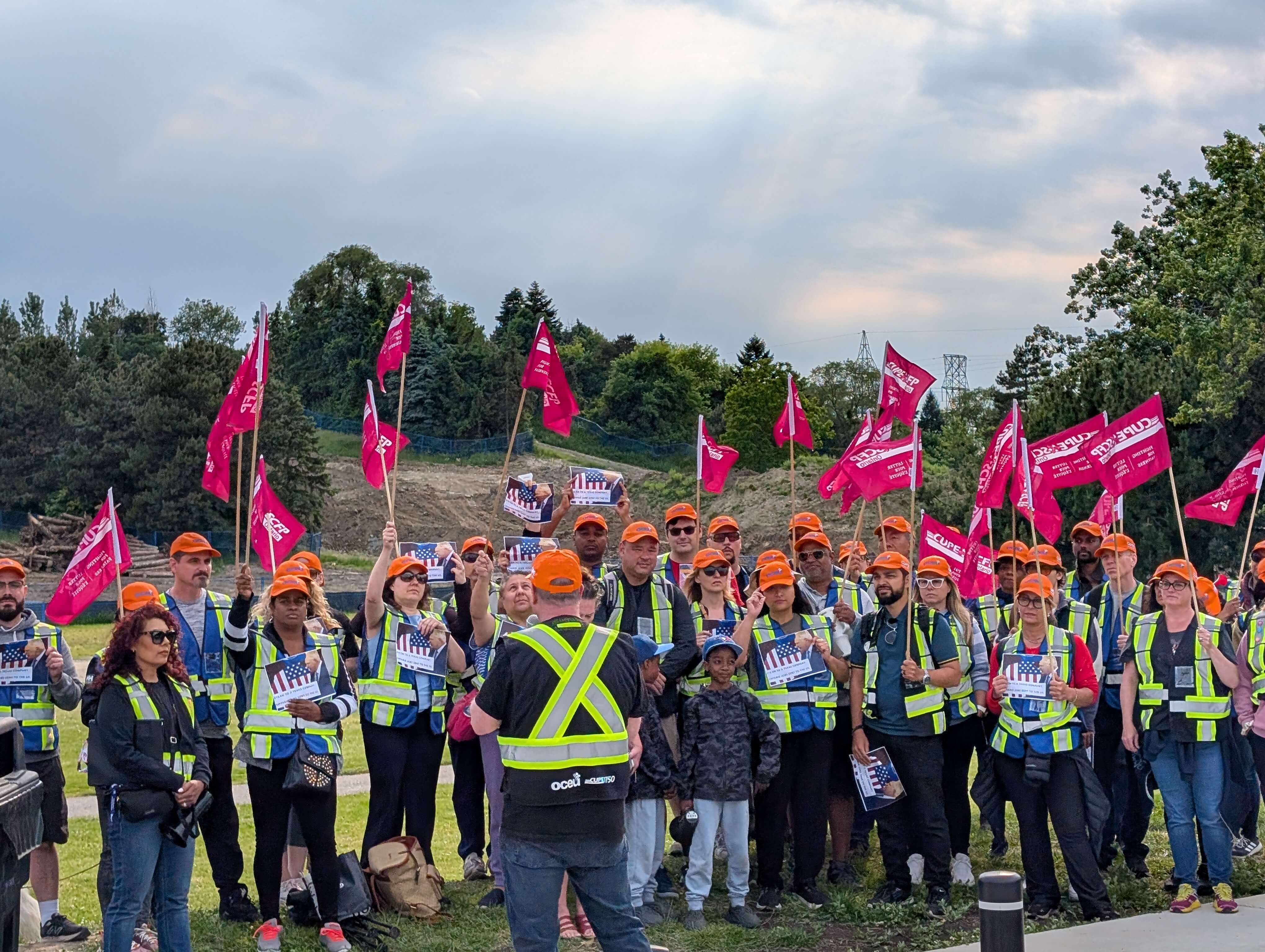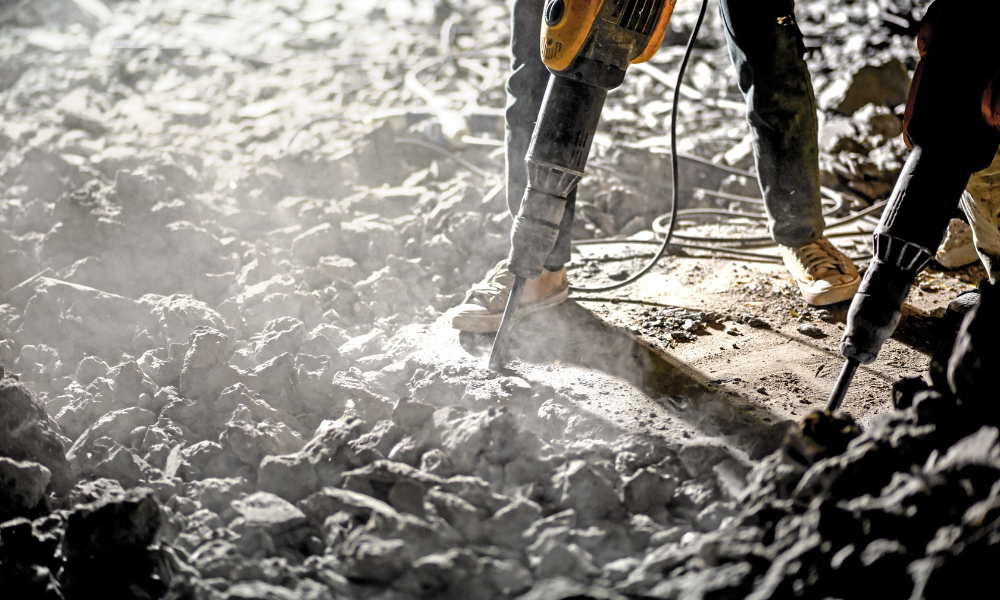Chainsaw pants are one of the most crucial components of a complete safety kit for certain industries. Get to know how to choose the best for your staff
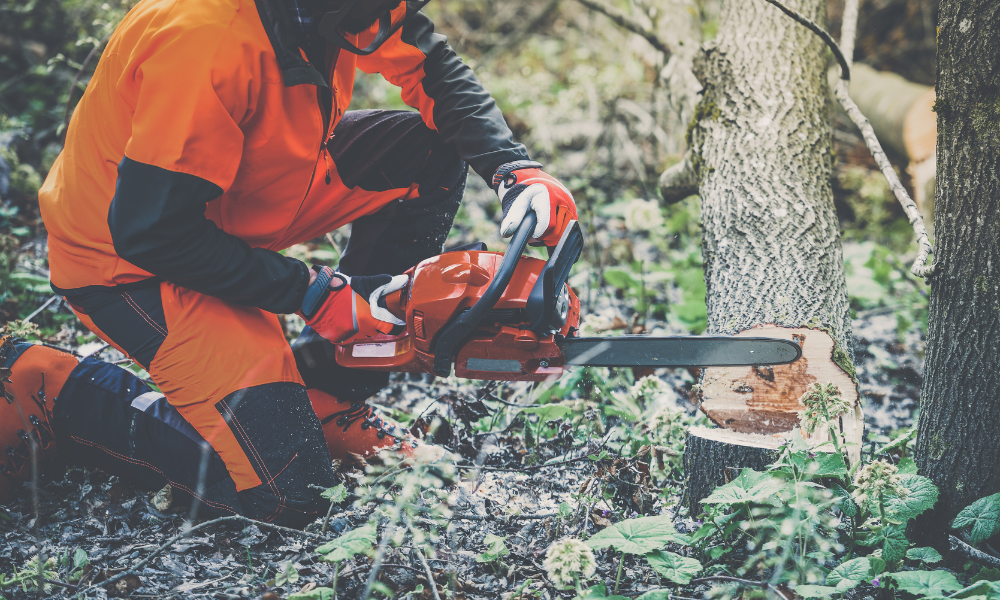
- 10 best chainsaw pants to recommend to your staff
- What are chainsaw pants and why are they important?
- Do chainsaw pants work?
- How do chainsaw pants or chaps work?
- What other PPEs do lumberjacks need?
- What is the difference between Type A and Type C chainsaw trousers?
- How long should chainsaw trousers last?
- How do you choose the best chainsaw pants in Canada?
- Where to buy chainsaw pants
It’s not hard to imagine that those who work in the logging industry must contend with a variety of hazards in their worksite. Of these hazards, lumberjacks and other workers who need to cut down trees mainly deal with the risk of getting cut by a very common and critical piece of kit – the modern chainsaw.
In this guide, Canadian Occupational Safety discusses the finer points of chainsaw pants. For instance, what are the best chainsaw pants in Canada? How do they work and where can you buy them? How do you care for this type of PPE? We'll answer these questions and more in this article.
10 best chainsaw pants to recommend to your staff
Here are some viable choices of pants and chaps that may be suitable for your company’s needs:
1. STIHL Standard 2600 Camouflage Chaps

Features:
- 1000 Denier nylon cutters chaps
- Main protective layer is certified 2600 threshold chain speed - Blended Kevlar
- Nylon-polyester pads of four layers
Made by world’s biggest name in chainsaws, these chainsaw pants from Stihl offer superior protection and work mainly by having its fibers clog the chainsaw, effectively stopping the drive sprocket.
2. Clogger TreeCrew Chainsaw Pants

Features:
- Patented and exclusive ArrestX HP chainsaw fabric for maximum mobility
- Six layers of chainsaw protection
- Outer fabric is a durable Lycra/polyester blend
- 360-degree protection for calves, with waist-to-ankle coverage
This is yet another type of chainsaw pants that work by clogging the chainsaw with fabric. The TreeCrew offers excellent protection on all areas of the wearer’s legs, from the waist down to the ankles.
3. Arborwear Ironwood Chainsaw Pants
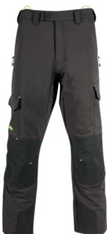
Features:
- Provides coverage from belt line to ankles
- Sawdust blocking pockets
- Durable Cordura outer fabric
- Temperature Regulating GeoCool lining wicks moisture/regulates body temperature
- FC-Free DWR (Durable Water Repellent) finish
These pants from Arborwear are composed of 89 percent Cordura Nylon and 11 percent Lycra. This personal protective clothing is durable and comfortable and offers reliable protection against accidental chainsaw cuts.
4. Husqvarna Technical Chainsaw Pants
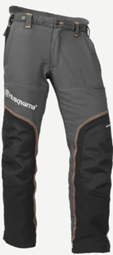
Features:
- Redesigned to provide optimum combination of safety, weight and temperature control
- Aramid-reinforced knees for enhanced protection from heat, chemicals, and abrasions
- Reflective logos for high visibility in worksites
- ASTM F1897 tested, complies with ANSI Z133 standard
These pants are made from 45 percent Cordura, 30 percent Polyamide and 25 percent Kevlar. Chainsaw users will appreciate its high resistance to abrasion coupled with its lightweight, breathable comfort.
5. Oregon Yukon Chainsaw Pants
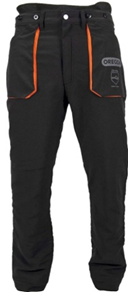
Features:
- Rated certified Class 1 protection (EN 381-5), with 5 to 6 layers of protective material
- Made with abrasion-resistant cotton and stretch polyester blend for optimum comfort and durability
- Fuel-, oil-, and heat-resistant
The Oregon Yukon provides an optimal mix of comfort, protection, and mobility thanks to its breathable material, moisture protection, and protections from typical hazards in forestry.
6. Pfanner Gladiator II Chainsaw Protection Pants
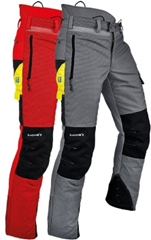
Features:
- Certified Class 2 protection
- Full wrap-around design offers 360-degree leg protection
- Made with patented materials like the extremely tear- and thorn-resistant Employ Gladiator fabric and StretchAIR technology for enhanced flexibility
These chainsaw pants from Pfanner are among the few types that offer excellent chainsaw protection along with high tear and puncture resistance and temperature control for all-season adaptability.
7. Blaklader 1920 Hi-Vis Chainsaw Pants

Features:
- Certified EN ISO 20471 Class 2 Cut protection
- Made of 70 percent polyester, 30 percent cotton twill blend for a water-repellent finish
- 4-way stretch fabric on the back for comfort and mobility and reinforced knees, suitable for both right- and left-handed users
With their added hi-vis features, these chainsaw pants are ideal for worksites with poor lighting conditions and staff working alongside heavy equipment and high vehicular traffic.
8. Forester High-Performance Chainsaw Protective Pants
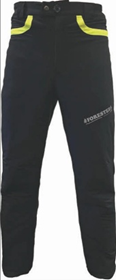
Features:
- Breathable stretch material for greater comfort and mobility
- Outer shell is designed to be both water-resistant and quick-drying
- 360-degree calf protection below the knee
- Meets Canadian ASTM standard, certified as Class A
These lightweight pants offer Class A protection from the user’s ankles to their waist. They are also all-season adaptable for year-round comfort and functionality.
9. Notch Armorflex II Chainsaw Pants

Features:
- Cordura high-abrasion 4-way stretch fabric allows greater flexibility
- Articulated knee protection made from Armortex abrasion-resistant fabrics
- Meets ANSI, ASTM F1897-2020 in accordance with ASTM F3325-20 Class C standard
These chainsaw protection pants combine maximum protection with high durability and comfort, meeting the needs of the most demanding forestry worker.
10. Kübler Forest Cut Protection Trousers Pro PPE 3
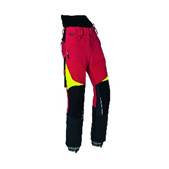
Features:
- Provides optimum visibility with its hi-vis contrasting areas
- Made from stretchable Cordura, making it water and dirt repellent
- EN 381-5 Class 1 certified
These pants include high-visibility contrasting yellow elements and reinforced pockets made of Cordura. They also have belt loops and a yardstick pocket designed for high utility and practicality for forestry applications.
What are chainsaw pants and why are they important?
As the name suggests, these are pants that workers wear when using chainsaws. They are part of the prescribed personal protective equipment (PPE) and are crucial for chainsaw safety.
Chainsaw pants vs chainsaw chaps: what’s the difference?
In your search for chainsaw protective pants, you may come across a similar variant, chainsaw chaps. In terms of material, there is often no difference between these two types of leg protection. However, there are important differences in terms of:
Protection level
Both chainsaw trousers or pants and chainsaw chaps offer a similar level of protection. They are both made from the same material that’s designed to clog a chainsaw and prevent it from cutting into the wearer’s legs (more on how they work later).
In terms of the level of protection they provide, chainsaw pants offer greater overall protection as they envelop the wearer’s legs and groin area. Chaps, meanwhile, only cover the front and sides of the wearer’s legs. Your workers may prefer the whole lower-body protection of chainsaw pants, particularly when they work in environments where there can be other hazards like falling debris.
Comfort and mobility
Chainsaw pants are considered better in terms of use. Pants are preferred over chaps when they must be worn for long, sustained periods. Chainsaw pants also have the advantage of being close to the body of the wearer and don’t have the hassle of getting snagged the way chaps might during climbing or doing chipping work.
Most models of chainsaw pants have mesh layers to allow breathability and minimize overheating. Chaps, on the other hand, are more advantageous in this respect, since they can be removed in hot weather – although this of course undermines their usefulness.
Cost implications
Pants are more expensive than chaps, since they use more material. However, the cost can be justified by the fact that this is a personal item and a critical PPE at that. Plus, issuing workers each with their own pair of chainsaw pants reduces the need for constant replacement. It’s more likely that workers will keep a personal piece of protective kit in tip-top shape. Meanwhile, chaps may be more cost-effective and can be shared by several workers and reduce the cost – if they are well maintained.
Do chainsaw pants work?
Yes, they do and are very effective in preventing serious injuries caused by chainsaws accidentally cutting or being mishandled by their operators. Here’s a short video of a man recounting how the chainsaw pants he bought saved him from a potentially lethal cut.
The fellow made the mistake of using only one hand to cut an errant tree stump, and the chainsaw slipped, nearly cutting into his femoral artery. Luckily, he was wearing his chainsaw pants:
How do chainsaw pants or chaps work?
A pair of chainsaw pants reduces the chances of its wearer getting cut by their own chainsaw. As prescribed by the European Standard EN 11393, a pair of chainsaw trousers or chaps should effectively protect their users by successfully executing these three principles:
1. Chain slipping
When a chainsaw’s chain comes into contact with the pants’ material, the chain does not cut the material but instead slips right off it.
2. Clogging
Clogging works when the protective fibres of the pants or chaps get tangled into the chainsaw via the drive sprocket. Then then stops the chain’s movement, leaving the wearer mostly unharmed.
3. Chain braking
This is a property of your chainsaw protective garment’s fibres. Chain braking ability pertains to a high resistance to cutting and capacity for absorbing rotational energy, which is how they reduce and eventually stop the chain speed.
Typically, an excellent pair of chainsaw pants would combine all three of these properties, but it’s not uncommon for these pants or chaps to have one or two properties.
Can you still get cut if you use chainsaw pants?
Yes, getting cut by a chainsaw even if the worker is wearing chainsaw protection like pants or chaps is a real possibility. The important difference is that their injuries would be several times more serious if they weren’t using these PPEs and the chainsaw unexpectedly cut them.
As with cut-resistant safety gloves, these PPEs do not provide 100 percent invulnerability or 100 percent protection from getting cut. These PPEs are generally meant to reduce the risk of injuries or minimize the damage. Remember: there is a world of difference between protective gear that is cut-resistant and cut-proof.
“Cut-proof” is a myth as you can only minimize damage or risks of getting cut and not eliminate them completely. Chainsaw protection kit like these pants is more of a last line of defense than a licence to be careless – keep in mind that no such chainsaw protective clothing or gear exists.
The bottom-line when it comes to these PPEs, they spell a huge difference when providing protection to their users. A pair of these pants can make chainsaw incidents require some band-aids or stitches, instead of a trip to the hospital or worse!
What other PPEs do lumberjacks need?
Be they lumberjacks, construction workers, or other workers that do forestry work, they’ll need other PPEs for their overall protection and safety. Remember that not all forestry-related incidents can be due to chainsaws, there are other hazards. If your staff typically perform tasks that involve chainsaws, here’s what they’ll need too:
- Safety googles – these are invaluable for eye protection, as cutting with a chainsaw can produce a lot of debris flying about at very high speeds and unpredictable directions. Check out our picks for the best protective eyewear to recommend to your staff in this guide.
- Face shields – apart from the safety goggles, a face shield can also be good to protect workers’ faces from flying debris.
- Hard hats – these are very useful for protecting workers’ heads from falling trees, branches, rocks, and other debris that can be kicked up or fall on their heads at the worksite. These are the best hard hats for your construction team.
- Steel-toed work boots – aka safety shoes, these PPEs are crucial also in worksites where your staff would be felling trees or clearing trees and similar debris. These are meant to protect their toes and feet from injuries caused by falling heavy debris or heavy equipment. Here are our choices for the most comfortable work boots for your staff.
- Safety gloves – thick, cut-proof safety gloves of the appropriate safety rating. For working with chainsaws, your staff will need gloves of the highest safety level, that of the American National Standards Institute (ANSI) level from 6 to 9.
ANSI standards cutting levels:
|
ANSI cut level |
Hazard risk |
Sample industries |
|
A1 |
Light cut hazards |
Packaging, construction |
|
A2 to A3 |
Light/medium cut hazards |
Materials handling, auto assembly |
|
A4 |
Medium cut hazards |
Food processing, bottle and light glass handling, HVAC repair |
|
A5 |
Medium/heavy cut hazards |
Food canning, electrical, metal fabrication |
|
A6 to A9 |
High cut hazards |
Forestry, metal stamping, recycling plant sorting, aerospace industry |
When looking for the right protective gear for your staff, don’t forget to find all the necessary PPEs that conform to your industry’s needs and safety standards. If your company is in the construction or logging industry, then you can also use this guide to know and find the appropriate safety equipment for your workforce.
What is the difference between Type A and Type C chainsaw trousers?
There are significant differences between these two types of chainsaw trousers.
- Type A – protects only the front of the wearer’s leg
- Type C – protects the wearer’s entire leg
It can be said that Type A pants are more like cowboy’s chaps, while Type C pants are more like, well, ordinary pants. Type A trousers would often be used by workers who do their tasks at ground level and are not at risk of chainsaw kickback from the rear. Whereas Type C trousers are more appropriate for arborists and other workers who risk getting injured by chainsaw kickbacks from all sides.
How long should chainsaw trousers last?
Their durability depends on how well their users maintain them and the quality of their construction build material. The lifespan of a pair of chainsaw pants can be extended, if you take note do the following:
1. Choose a pair with stronger cut-resistant fibers and more durable protective material. These will typically last longer.
2. It is recommended that you replace chainsaw trousers between 35 and 50 washes. For washing the pants it’s fine to use a washing machine, but it's recommended to do air drying (no tumble drying and no fabric softener) for them.
Note that it’s not the washing that causes the maintenance problems. It’s the contamination of the pants material from substances, like fuel, chain oil, sawdust, and sweat, that reduces the protection level. These can damage the fibers or make them stick together. In short, the less times you wash them, the less protection they will provide.
3. It’s recommended to apply an oil and water repellent finish on the pants; this can also increase their safety level.
4. Buy chainsaw pants that are “developed for repair.” This means that the pants should be made so the user may repair the fabric outer layer. Keep in mind that if you choose to repair a used pair, never stitch through the protective inlay. The pants’ blocking material must never be altered or tampered with, only the outer pants fabric can be fixed.
How do you choose the best chainsaw pants in Canada?
In your search for the best chainsaw pants for your staff’s needs, you will likely encounter a lot of choices. To help you choose correctly, there are standards you can use and follow as a guide.
The Canadian Standards Association (CSA) and ANSI provide the referential standards for choosing the trousers that are appropriate for your needs.
The standard that specifically governs chainsaw pants is CAN/CSA Z62.1. This outlines specific cut-resistance levels that protective clothing (like chainsaw trousers or chaps) must adhere to provide sufficient protection.
Performance criteria
1. Cut-resistance testing – this feature is tested using a specialized machine that applies a specific load to a blade that is moved across the material. The results of this test determine the compliance of the material as compared to the standard.
2. Rating system – this standard uses a rating system ranging from 1 to 5 (least to most cut resistant).
- Level 1: Minimal cut resistance, suitable for low-risk environments
- Level 2: Moderate level of cut resistance, fit for environments where chainsaws are seldom used
- Level 3: High cut resistance, used by regular chainsaw operators
- Level 4: Very high cut resistance, used by professional arborists or those in high-risk worksites
- Level 5: Maximum cut resistance, suitable for specialized industries and extreme conditions
Where to buy chainsaw pants
Chainsaw pants or chaps may be purchased at hardware stores or Home Depot stores. Amazon Canada also carries these products. If you need bulk orders, there are several brick-and-mortar stores you can find online or visit.
Choosing chainsaw chaps or chainsaw trousers depends on your company’s unique circumstances and needs. To choose the best of either, consider the environment your staff works in, the policies of your employer, and industry regulations. Good chainsaw pants can be bought at different price points, so you can have suitable safety equipment with nearly any budget.
Did you find this article on chainsaw pants helpful? Let us know your thoughts in the comments



